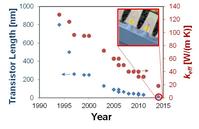Evaluating Broader Impacts of Nanoscale Thermal Transport Research
Evaluating Broader Impacts of Nanoscale Thermal Transport Research
| Event Date: | June 5, 2015 |
|---|---|
| Authors: | Li Shi, Chris Dames, Jenifer R. Lukes, Pramod Sangi Reddy, John Duda, David G. Cahill,
Jaeho Lee, Amy Marconnet, Kenneth E. Goodson, Je-Hyeong Bahk, Ali Shakouri, Ravi S. Prasher, Jonathan Felts, William P. King, Bumsoo Han, John C. Bischof |
| Journal: | Nanoscale and Microscale Thermophysical Engineering |
| Paper URL: | Link to Full Text |
The past two decades have witnessed the emergence and rapid growth of the research field of nanoscale thermal transport. Much of the work in this field has been fundamental studies that have explored the mechanisms of heat transport in nanoscale films, wires, particles, interfaces, and channels. However, in recent years there has been an increasing emphasis on utilizing the fundamental knowledge gained toward understanding and improving device and system performances. In this opinion article, an attempt is made to provide an evaluation of the existing and potential impacts of the basic research efforts in this field on the developments of the heat transfer discipline, workforce, and a number of technologies, including heat-assisted magnetic recording, phase change memories, thermal management of microelectronics, thermoelectric energy conversion, thermal energy storage, building and vehicle heating and cooling, manufacturing, and biomedical devices. The goal is to identify successful examples, significant challenges, and potential opportunities where thermal science research in nanoscale has been or will be a game changer.

